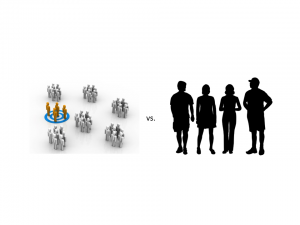If you have done any reading lately on how to effectively implement content marketing and social media into your marketing strategy, you have likely come across the concept of buyer personas. In fact, understanding and clearly defining buyer personas is widely considered to be the first step to successfully engaging customers and leads via digital marketing. But if this talk about buyer personas is foreign, you may be wondering how personas relate to a cornerstone element of marketing strategy- your target market. Let’s delve into this issue by comparing personas and target market along certain key characteristics.
First, Some Definitions
Before going any further, defining buyer persona and target market is a logical starting point:
Buyer persona- Research-based archetypal (modeled) representations of who buyers are, what they are trying to accomplish, what goals drive their behavior, how they think, how they buy, and why they make buying decisions, where they buy as well as when buyers decide to buy. (Source: Tony Zambito)
Target market- The particular segment of a total population on which the seller focuses its expertise to satisfy that submarket in order to accomplish its profit objective. (Source: American Marketing Association)
Both concepts pertain to customers, but the similarities pretty much end there.
What’s the Difference?
The concepts of buyer persona and target market represent two different approaches for identifying potential customers and using insights gleaned to devise marketing campaigns to reach them. Below are five characteristics along which personas and targets are compared:
|
Characteristic |
Buyer Persona |
Target Market |
| Scope | Individual | Aggregation |
| Focus | Persons (Buyer, customer, or user) | Likely buyers |
| Influencers | “Life characters” (e.g., family, friends, colleagues) | Other targets (e.g., aspirational groups) |
| Data Points | Personal story lines (Priorities, successes, obstacles faced) | Descriptive traits (demographics psychographics, and behaviors) |
| Marketing Focus | Gathering and understanding buyers’ stories in their own words | Capturing historical data, trendspotting, and customer research |
Buyer personas get to the heart of the marketing concept: Satisfying needs and wants. The research required to gather insights into the who, what, why, when, and where of their lives allows for a clearer view of the audience a business is attempting to serve. Why? A persona distills the crowd down to individual customer types. In contrast, target marketing historically has focused on aggregation- how to logically group together people or firms with similar characteristics that are our most likely buyers.
The difference in scope between buyer persona and target market is the most significant difference between the two concepts because it accounts for the contrast in the other four characteristics identified in the table above. It is no coincidence that the term buyer persona contains the word “person;” the characteristics of a buyer persona all relate to the person with whom you desire to engage in a relationship with your brand.
Don’t Discard Target Marketing
The purpose of this discussion is not to ask you to choose between buyer persona and target marketing as the tool of choice when formulating marketing strategy.Personas and target markets should play complementary roles in managing customer relationships. Target marketing is useful because it is a first step in reducing the population of potential buyers to smaller pools of the most likely buyers and users of your products or services. The need remains to drill down deeper to understand each segment you serve and in turn, how to respond to them via product design, distribution strategy, and brand communications.Creating buyer personas meets that need, providing clarity that can equip you to better serve current customers and successfully attract new ones.


Hi,
I like the way you make the distinction between the target market and the buyer persona. Do you not think buyer persona falls inside the target market? I would love to read your opinion please.
Thanks for your comment, Juan. A persona is a granular representation of the target market, which tends to be viewed in aggregate. So yes, a persona falls inside the target market. A persona gives a clearer picture of the typical user.
Unlike the concept of target or target group, which is more abstract and brings together a number of people without their own identity, the buyer persona does not have to refer to a single market segment. It s more complex than that. And most importantly, the buyer persona is such that, rather than focusing only on aspects such as sex, age, or purchasing power, it defines their needs ( pains ). If you know the pain of your ideal customer, you know what motivates them ( the driver ) to perform a search on Google. And that s where you have the key to your marketing strategy.